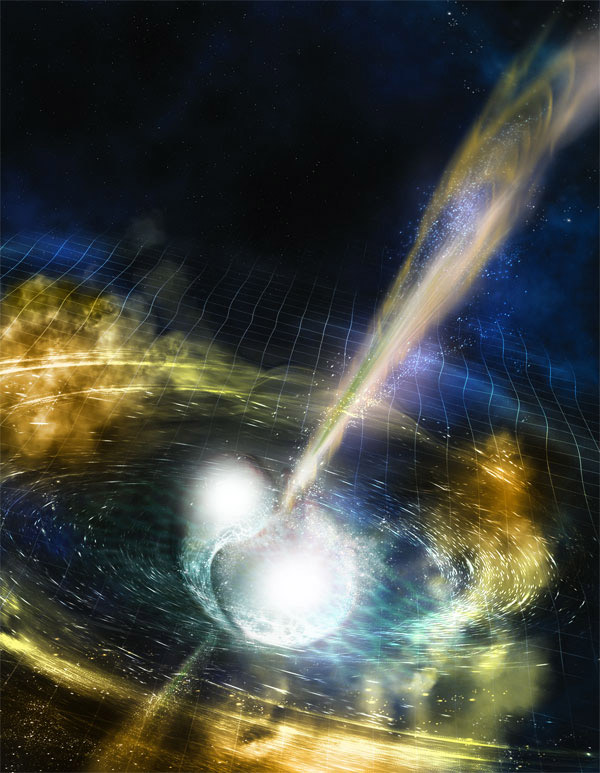A global effort, with contributions by McGill astrophysicists including Assistant Professor of Physics in the McGill Space Institute (MSI), Daryl Haggard, and postdoctoral researcher Melania Nynka, has detected gravitational waves coming from the collision of two neutron stars in orbit. Among the many implications of this discovery, the origin of certain elements—such as gold—emerged.
Gravitational waves are piquing the public’s interest in physics. These waves are disturbances in space-time caused by the collision of large astronomical bodies as they orbit each other at increasing velocity. Theorized by Einstein in 1916, evidence for the existence of gravitational waves has only recently become available—the 2017 Nobel Prize in Physics was given to Rainer Weiss, Barry C. Barish, and Kip S. Thorne, for their contributions to the detection of the gravitational waves and the Laser Interferometer Gravitational-Wave Observatory (LIGO). Previous recordings of gravitational waves were from the merging of black holes.
Recently, the first emanation of these waves from the collision of two neutron stars has been confirmed by scientists across the globe, including Haggard and Nynka; marking the first of these types of collisions to release gravitational waves and light radiation.
“[This] signal lasted much longer than the first four,” Govert Shilling wrote for the Sky and Telescope. “[Instead] of a fraction of a second, like the earlier detections, the spacetime ripples lasted for a whopping ninety seconds.”
Furthermore, electromagnetic radiation was released by the collision in the form of a flash gamma radiation, detected by both NASA and the European Space Agency. This combination of different types of emissions released from the collision has never been seen by astronomers.
Haggard was involved in the discovery, and explained that neutron stars sometimes pull on another neutron star to form a binary system—when two stars rotate around the same center of mass. As they orbit closer to each other, the final collision releases gravitational waves and violent bursts of gamma radiation out into distant space. The gravitational waves travel at the speed of light, virtually unimpeded throughout the universe. By the time they reach Earth, the warping of space-time that the planet experiences is about a fraction of the width of an atomic nucleus, and has a negligible effect.
The effort to detect such events is enormous. Nynka, who also worked on this project at the MSI, stressed that this slight detection was monitored heavily.
“[One] third of the entire astrophysics and astronomical community, around the world, was involved in observing this,” Nynka said.
These events are hard to detect because of the accuracy required. Lasers travelling long distances have to be perfectly calibrated so that only a gravitational wave will warp the path of the lasers out of sync with each other. Nynka pointed out that varied sources, such as waves on a shore, passing trucks, or distant seismic activity, can throw off results.
However, with the project successfully confirming the presence of gravitational waves resulting from two colliding neutron stars, other downstream implications of the discovery emerged. The data confirmed theories about the cosmic origin of heavy elements, like gold.
The early expansion of the universe was too rapid, and the temperature changes too great, to be able to produce many of the heavier elements. However, many astronomical collisions were theorized to be able to produce the right temperatures, which sustained over a sufficient amount of time, can generate these elements.
Haggard explained that dying stars undergoing supernova explosions become increasingly dense, and have so much gravity inside them that they force protons and electrons together, creating a vast supply of neutrons. Thus, neutron star collisions can potentially provide the right conditions for mid-weight range elements, like iron, to capture neutrons and acquire mass. Haggard explained that sometimes this even happens on earth—during the fallout of a thermonuclear explosion.
It may be romantic to say that the gold in our wedding rings came from distant bursts of colliding stars. To astronomers, however, these findings may help better understand how matter forms and coalesces in the universe—clumping together to turn space dust into planets and, eventually, life.









